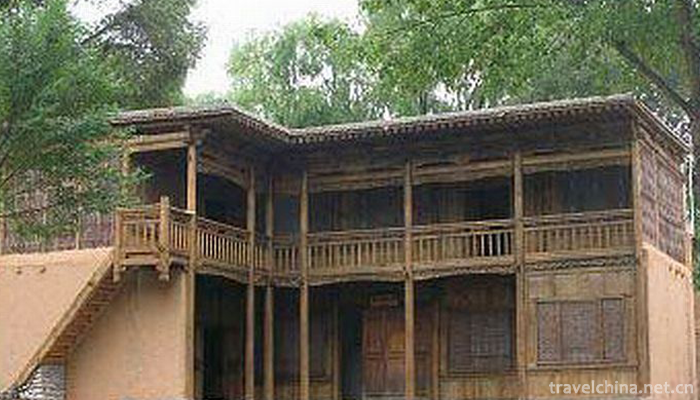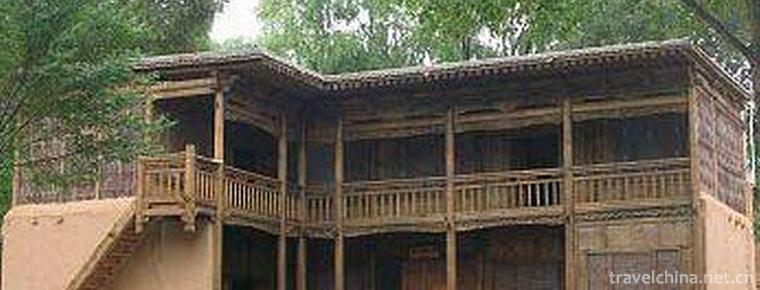Construction Techniques of Salar Fence Tower
Construction Techniques of Salar Fence Tower
The construction technique of the fence building of Sala nationality refers to the traditional construction method of the fence wooden building with the unique architectural form of Sala nationality in China and the intangible cultural heritage project at the national level in China. The fence building of Sala's ancient folk houses is an old building of mixed civil and stone. Because most of the walls of the buildings are woven with rattan, it is named fence building. In 1989, the state issued residential stamps, of which Qinghai residential is the Salar fence building. Its construction techniques accumulate the unique cultural phenomena of the Sala nationality, which is a rare architectural art on the plateau with regional characteristics of one ethnic group. It is of great significance to the study of Salar folklore.
historical origin
The Salas migrated from Salak (Turkmenistan) to Xunhua County in the 13th century (early Yuan Dynasty). Scatter
The fence building of La nationality's ancient dwelling is an ancient dwelling building with wood, stone and soil mixed together. Because most of the walls of the building are made of tree bars, it is named fence building. By the beginning of the 21st century, it only existed in Mengda area in Xunhua County. Mengda area, known as Heguandi in ancient times, has been a major transportation hub between Gansu and Qinghai. From the 13th century to the 14th century (Yuan Dynasty), the Salars living in Mengda gave full play to their talents and wisdom, exploited woodlands, utilized local natural forest, earth and stone resources, and interacted with the surrounding Tibetan, Han, Hui, Tu and Baoan nationalities to build up a rich multi-ethnic culture. A fence building was built. Therefore, the fence building not only records the architectural characteristics of different times, but also the historical memory of Salar architectural style. At the same time, it accumulates multi-ethnic cultural phenomena. It is a rare ancient building on the plateau with regional characteristics of one ethnic group.
Architectural features
According to the investigation at the beginning of the 21st century, the preserved fence buildings of Salar ancient dwellings are mainly located in Mengda Dazhuang Village, Qingshui Township, on the Bank of the Yellow River in Xunhua County, which is close to Mengda National Nature Reserve. The fence buildings are built freely according to the local conditions, including horizontal, corner and triad courtyards. The fence timber building is usually divided into upper and lower floors, with bedrooms and guest rooms on the upper floor and warehouses and livestock pens on the bottom. The frame of the fence building is made up of well-wooden pine. The walls are woven with miscellaneous wood branches and covered with grass mud on both sides. The middle of the wall is hollow. The doors, windows and pillars of the house are mostly carved with exquisite patterns.
The building constructed by this method not only saves building materials, but also reduces the weight of the building. At the same time, the hollow wall is warm in winter and cool in summer, and has strong air permeability. The fence building design of Sala nationality has the most distinctive architectural style in Ming and Qing Dynasties. During this period, the social and economic life of the Salar people has been developed, and the population has been increasing. Building is firm, beautiful, economical and flexible, highlighting the role of wind, earthquake, applicability and safety, so fine pine wood is usually selected.
The fence building complex basically maintained the original form, and maintained the original social grass-roots organization style of the Salar people in the local history, which is of great significance to the study of the Salar people's folklore. At the beginning of the 21st century, Qinghai Province took a series of measures to protect these ancient buildings.
Protection
The demolition and renovation of the fence building was reduced from more than 100 in 1960s to 14 in the early twenty-first Century. In June 2008, the building techniques of the Salar fence building were selected in the national intangible cultural heritage list in June 2008. The 4 outstanding buildings in the 14-19 Century (Ming and Qing Dynasties) were included in the provincial cultural relic protection units in Qinghai province. At the same time, 1 Salar ancient houses in Qing Dynasty were relocated to the Beijing Chinese nation. Museums are renovated and protected. With the development of rural economy, the phenomenon of artificial demolition of building communities is prominent, and fence buildings are on the verge of extinction. In order to improve the living standard of Salar people, people pay more attention to the practicality and beauty of houses, and pursue real material enjoyment. Little is known about the value of cultural relics in fence buildings and the inheritance of Salar culture, and it is difficult to effectively protect them.
Representative heir
Ma Jinming, a retired cadre of the Salar Culture Museum, is skilled in the fabrication techniques of the fence buildings. He was selected as the representative successor of the national intangible cultural heritage project, and organized the fence building skills training in Dazhuang Village, Mengda, in order to protect and develop the ancient architectural and cultural landscape of the Salar people, so that villagers can further understand the fence through training. The cultural value of Tulou includes that the county government organizes annual photography exhibition of Salar ancient residential buildings and seminars on Salar ancient residential buildings to promote the protection and inheritance of fence buildings.


-
1.The Badaling Great Wall
Juyongguan Great Wall is a famous ancient city along the Great Wall of Beijing and a national cultural relic protection unit. It is a national AAAA scenic spot assessed by Beijing Tourism Bureau
Time 2018-12-09 -
2.Dajiaowan Scenic Area Hailing Island Yangjiang
Dajiaowan Scenic Spot of Hailing Island in Yangjiang, located in Zhapo Town of Hailing Island in Yangjiang City, Guangdong Province, is a famous national AAAAA tourist attraction
Time 2018-12-12 -
3.Beijing Planning Exhibition Hall
Beijing Planning Exhibition Hall, located in Qianmen East Street (east side of old Beijing Railway Station) of Dongcheng District of Beijing, is renovated on the basis of the original building.
Time 2018-12-26 -
4.Bao Mo yuan
Baomo Garden is located in Zini Village, Shawan Town, Panyu District, Guangzhou City, Guangdong Province. It was built in the late Qing Dynasty and covers an area of five mu
Time 2019-01-02 -
5.Xisha Wetland of Pearl Lake
Located in Luhua Town, west of Chongming Island, Shanghai Mingzhu Lake is the largest natural inland lake on the island. It is also the main area of western water recreation
Time 2019-02-07 -
6.Korean Crane Dance
Crane Dance of the Korean Nationality has a long history and is a unique dance performance form of the Korean Nationality in China. It has the national characteristics and the value of artistic resear
Time 2019-04-16 -
7.Huian womens clothing
Hui'an women refer to a group of special folk women on the coast of Huidong Peninsula, Hui'an County, Quanzhou, Fujian Province. They are famous at home and abroad for their unique clothes and diligen
Time 2019-05-04 -
8.Mongolian embroidery
Mongolian embroidery is a kind of handicraft craft formed in the long-term production and life of the Mongolian people in China. Mongolian embroidery not only embroiders on soft fabrics, but also embr
Time 2019-06-03 -
9.Sichuan Zhuqin
Sichuan Zhuqin is an ancient traditional opera. The performers hold fishing drums and rap stories. The original name is Mingqin. Because its accompaniment instrument is a bamboo drum drum, it is also
Time 2019-06-16 -
10.Chengdu University
Chengdu University, established in 1978 with the approval of the Ministry of Education, is a comprehensive University jointly built by Sichuan Province and Chengdu City. It is a key comprehensive univ
Time 2019-08-31 -
11.Wawu mountain
Wawu Mountain National Forest Park is under the administration of Hongya County, Meishan City, along the western edge of Sichuan Basin. It is 180 km away from Chengdu and covers an area of 1.05 million mu.
Time 2020-10-15 -
12.wolong national nature reserve
Wolong Nature Reserve is located in the southwest of Wenchuan County, Aba Tibetan and Qiang Autonomous Prefecture, Sichuan Province, on the southeast slope of Qionglai mountains, 130 kilometers away from Chengdu
Time 2020-11-06